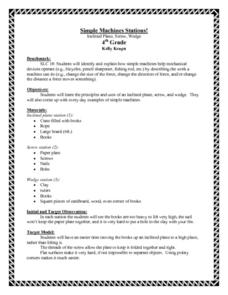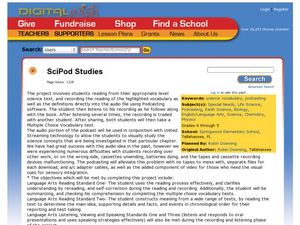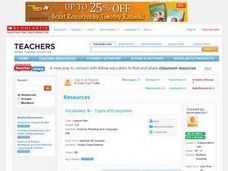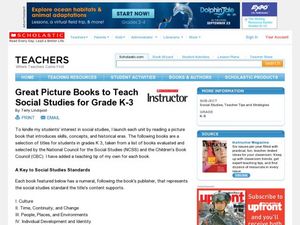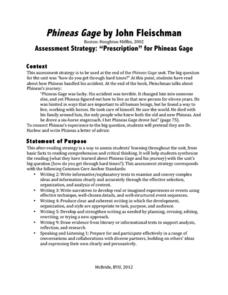Curated OER
Simple Machines Stations!
Fourth graders investigate the principles and uses of an inclined plane, screw, and wedge and identify examples of simple machines. They rotate through three experiment stations, complete a worksheet for each station, and read a handout...
Curated OER
The Human Eye
In this reading comprehension activity, students learn about the human eye by reading a 2 page passage and studying a diagram of the eye. Students answer 8 questions, and label a diagram of the eye.
Curated OER
Mr. Ben's Farm
In this reading comprehension worksheet, learners read a short story about a farmer. Students complete a crossword puzzle, questions, and short answer activities in response to the story.
Curated OER
Deadly Deserts
In this reading comprehension worksheet, students read a passage regarding different deserts and answer 10 questions. The questions are a mix of true/false, short answer, and matching.
Curated OER
Oklahoma Stone Soup
Students discover the history of the Oklahoma Territory and what foods cowboys used to eat while on the move. In this culinary lesson, students read the ingredients to Oklahoma Stone Soup and prepare them in a crock pot over the...
Curated OER
The Gift of Life - Day 2: "Cell & Organelle Time to Tell" and "World in Color" (Chapters 2-4)
Students complete a cell biology lesson plan and a color lesson plan based on The Giver. In this biology and reading comprehension lesson plan set, students examine cells using microscopes. They look at the organelles and listen to How...
Curated OER
Boa Constrictors
In this expository comprehension worksheet, students read a 1-page informational article about boa constrictors and then answer 3 short answer and 2 multiple choice questions.
Curated OER
Frog Or Toad?
In this expository comprehension worksheet, students read a 1-page informational article about frogs and toads, answer short answer questions, and fill out a Venn diagram to compare the two amphibians.
Curated OER
Mount Everest Reading Landmarks
In this science worksheet, students read a content passage concerning facts about Mount Everest. Then they answer 6 questions and the answer sheet is on page 3.
Curated OER
SciPod Studies
Have fun preparing a science podcast. After reviewing vocabulary, learners record audio files to create science vocabulary podcasts for particular units of study. A clever way to incorporate technology.
Curated OER
The Very Hungry Caterpillar
Here is a good lesson on butterflies and caterpillars. After listening to The Very Hungry Caterpillar, young learners put cards that depict the life cycle of a butterfly in the correct order. There are some good ideas for center...
Curated OER
Old Lady That Swallowed a Fly
Youngsters listen to the story, "There Was an Old Lady Who Swallowed a Fly." After discussing the story, going over new vocabulary, and repeating the rhymes in the story, they study the parts of a fly. They finish by creating a fly on...
Curated OER
Astronauts Build Space Station Addition
Students read a story called Astronauts Finish Building Space Station Addition and answer vocabulary and comprehension questions about it. In this space station lesson plan, students respond to literature by answering questions,...
Curated OER
Vocabulary: Types of Ecosystems
Pupils practice using vocabulary words from life science. They will investigate the ecosystem and the terms that are associated with it. In addition, they will complete a fill-in-the-blank exam using the vocabulary words.
Curated OER
The Mastodon Kill
Using the book Bandits, Bears, and Backaches, learners develop an understanding of the pre-history of Arkansas. They follow the trail ofthe giants mastodons and paleo Indians who lived there long ago. The emphasis on this lesson is on...
Curated OER
Great Picture Books to Teach Social Studies for Grade K-3
Every class enjoys reading new books at the beginning of a unit. Use this resource to identify a variety of books for kindergarten to third grade that can be used to complement social studies standards. The books can kindle learners'...
Core Knowledge Foundation
Unit 4: The Time Machine by H. G. Wells Teacher Guide
Lead your readers into the fourth dimension as time travelers with a Core Knowledge Language Arts (CKLA) Teacher Guide of H. G. Wells's The Time Machine. The 144-page guide includes a unit calendar, introduction, nine lessons, teacher...
Curated OER
Butterfly, Butterfly: Teaching Vocabulary
Kindergarteners practice new words through listening to and reading the science book Butterfly by Jenny Feely. The teacher will first choose words that are essential for understanding the text. Then, using pictures in the text,...
Curated OER
Phineas Gage: Assessment Strategy
Close up your study of Phineas Gage: A Gruesome but True Story About Brain Science with a letter-writing assignment. Pupils prepare by journaling and sharing with a partner. They then compose letters that focus on a big idea from the...
Weber State University
The Sun and the Seasons
Why is there more daylight in June than in December if you live above the equator? How does the angle of sunlight shift throughout the year? Answer these questions and more with an interactive article about the sun, its path through the...
Curated OER
Ready-Set-Tech: When a Volcano Erupts
Wouldn't it be a blast to uncover the science behind volcanic eruptions? Explore, research, and examine the nature of volcanoes with three fun hands-on projects kids will love. First the class takes to the Internet to research volcanoes....
Curated OER
Make a Mission
Students discuss the terms exploration and technology. They read about the MESSENGER, Mission to Mercury, and answer questions. Next, they design and plan the technology for a space mission using an online interactive activity.
Rainforest Alliance
Colombia Biodiversity
How diverse is the rainforest? How much more diverse is a rain forest than a temperate forest? Explore these focus questions in a instructional activity that explores the plants, animals, and insects in forests. After...
Biology Junction
Characteristics of Life
This is an extensive resource that focuses on the characteristics of life. Scientists read a series of short passages, highlighting main ideas and answering comprehension questions as they go. After they have completed the reading,...


